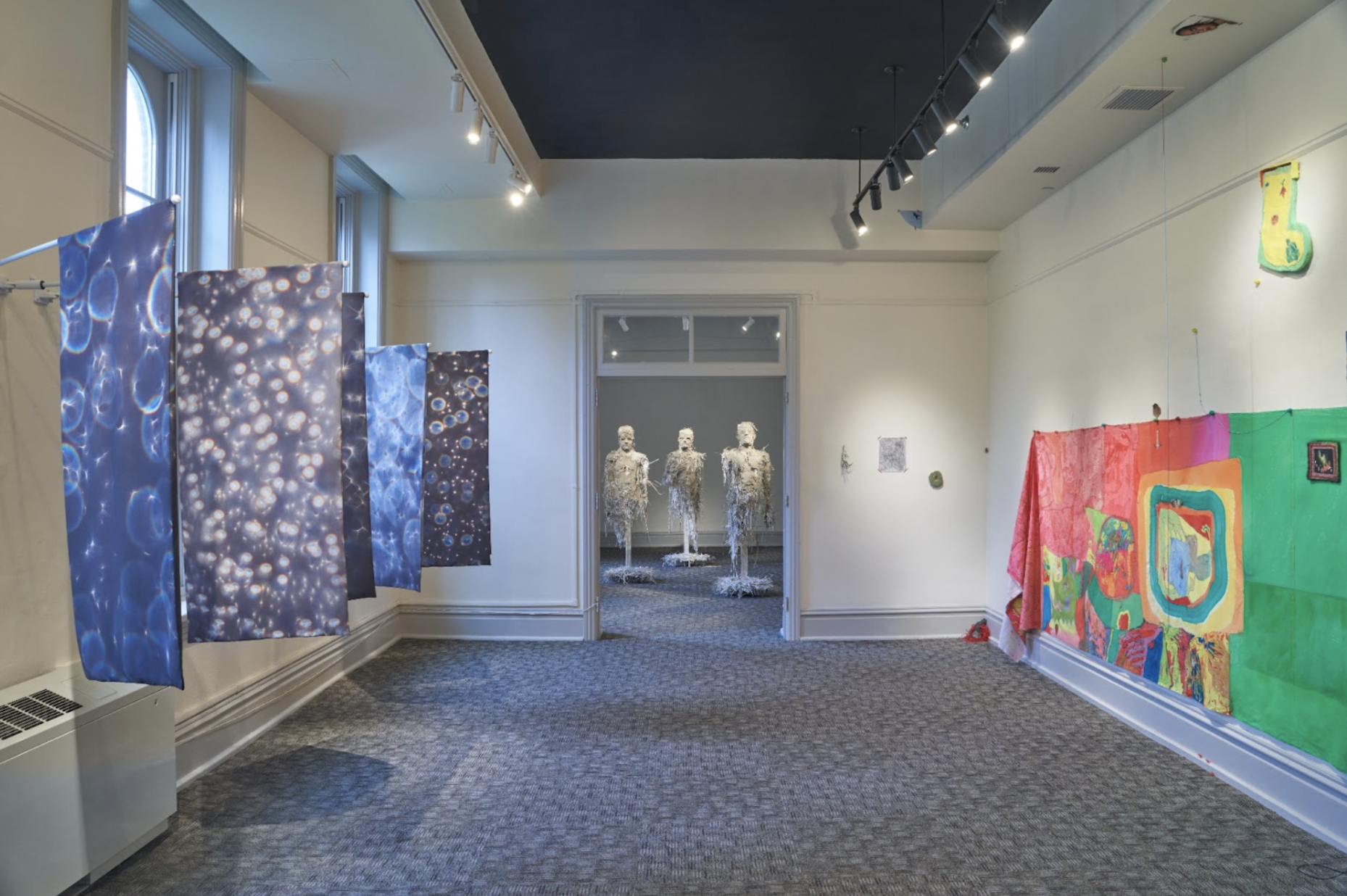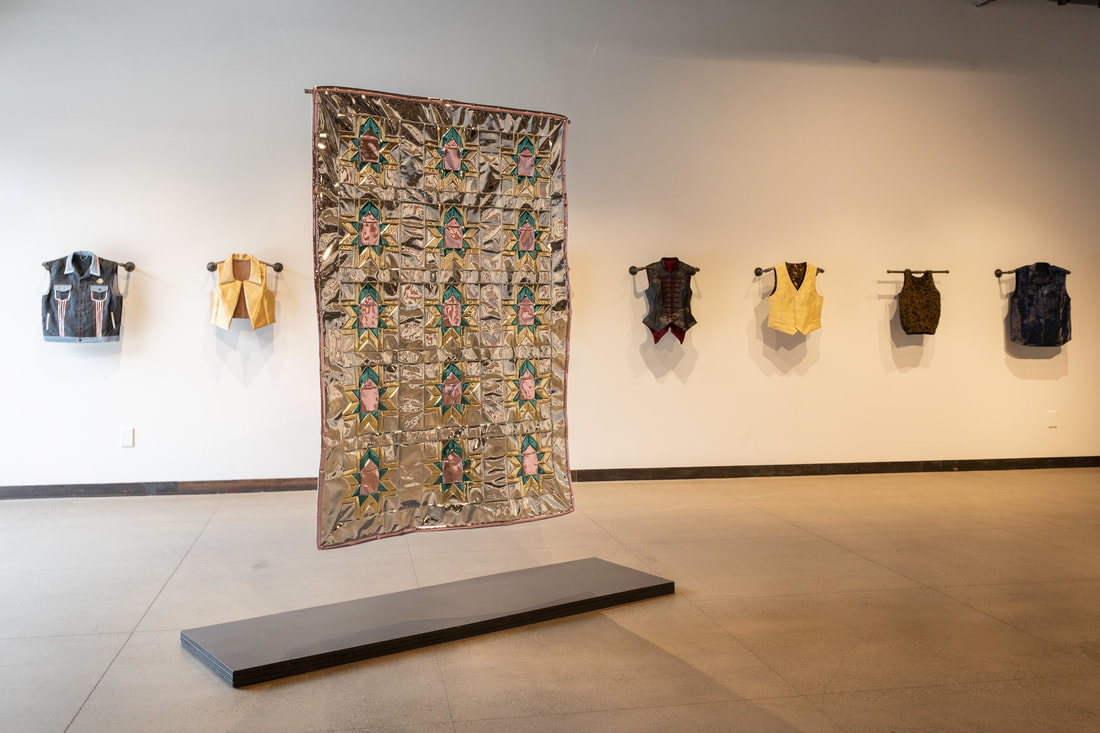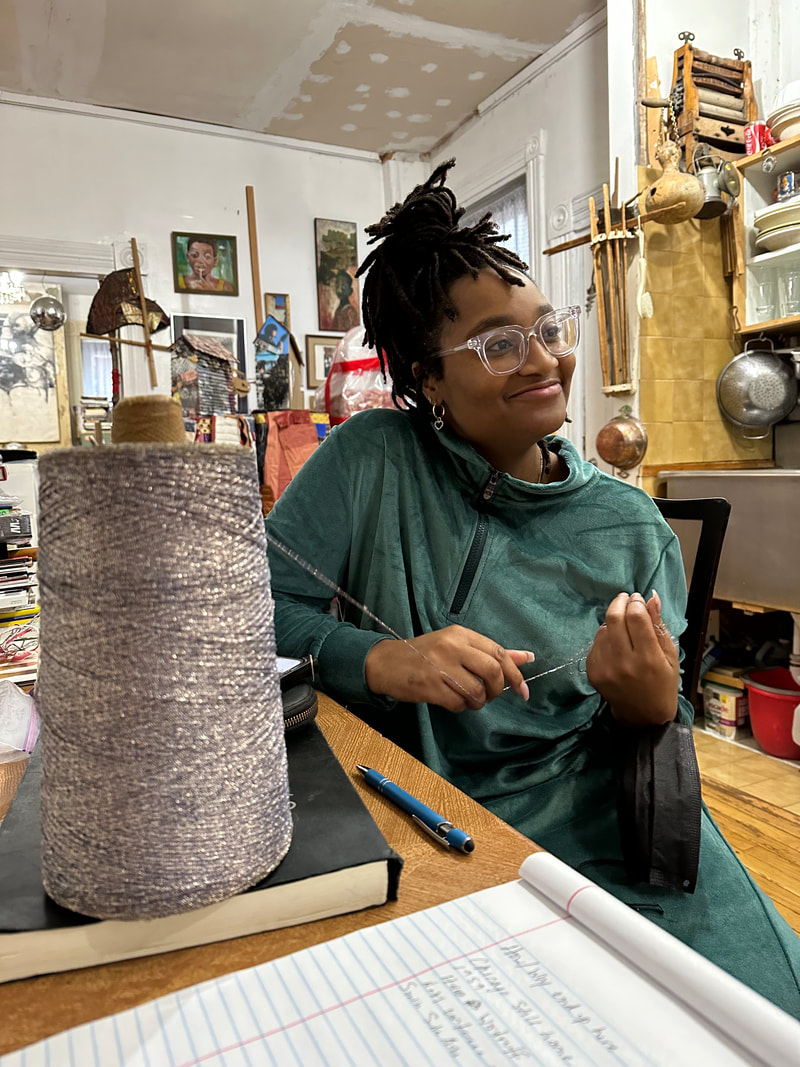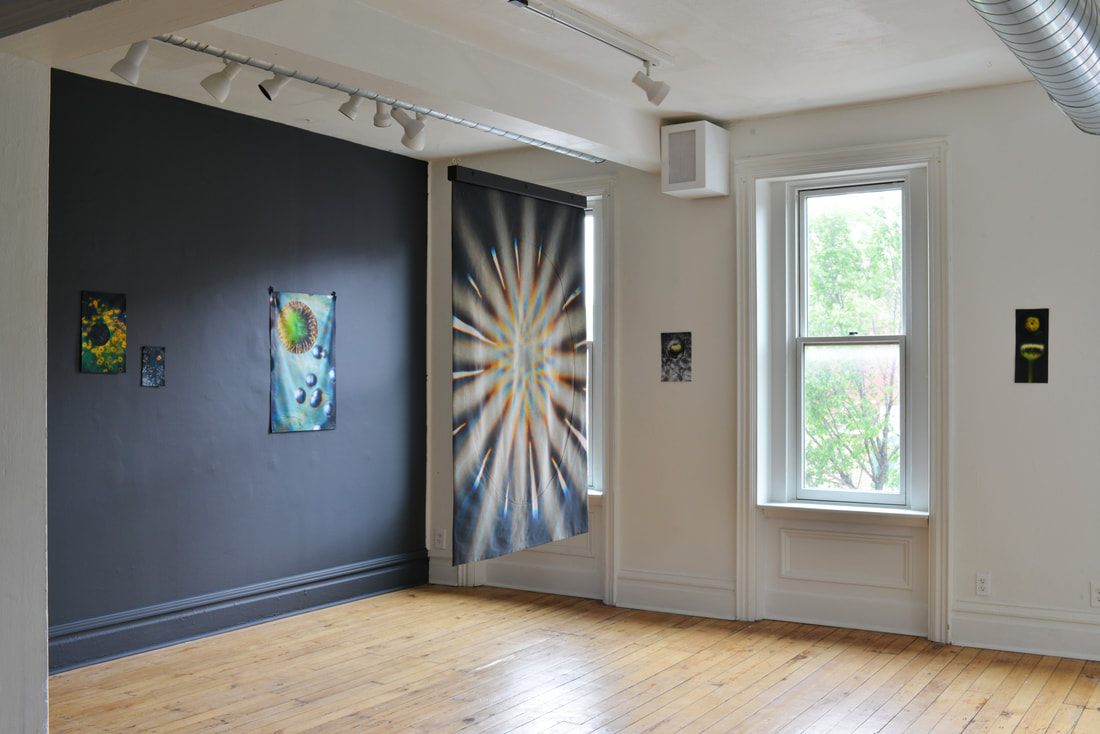Breaking Through Isolation: Six in an Open Field at the University Museum at Indiana University of Pennsylvania.
Review by Alaine Lambertson

Installation view of Six in an Open Field at Indiana University of Pennsylvania
The views and opinions expressed in this article are solely those of the author. They do not reflect the opinions or views of Bunker Projects or its members. All images courtesy of Travis Mitzel.
Six in an Open Field (2023) presents the diverse works of a collective of six Pittsburgh-based artists: Carolina Alamilla, Sidney Mullis, Paul Peng, Andrew Allison, Centa Schumacher, and Peter Barbor. Organized around the concept of artistic networks and support rather than a traditional focus on theme, media, or style, a clear awareness of self and community unites the rich creative practices of ceramics, wallpaper, mixed media sculpture, graphite and ink drawing, photography, and installation.
Six in an Open Field directly engages the concept of disjointed and unified space; the seven rooms in the gallery convey the different emotional and physical environments of the six artists, as the distinct and dissimilar pieces express the human experience of isolation and connection. Some artists remain confined to their own rooms, isolated, whereas others share spaces, the artworks living together. The fluidity between galleries, however, breaks down total isolation, as visual juxtaposition of works exists across separated spaces—a metaphor for the network which binds these talented individuals.

Carolina Alamilla, Floral Pinstripes (Pink and Blue)(2023)
The exhibition begins with Carolina Alamilla’s vibrant pink, blue, and white wallpaper and ceramics. Her installation activates the room, infusing it with dynamic energy. Two distinct wallpaper patterns decorate the small room; one presents large blue and small white ceramic flowers on a purple and pink background, and the second features large blue and small white ceramic flowers on light and dark blue and white stripes. Alamilla evokes feelings of home with the media of wallpaper, but the almost jarring overlay of the two designs underscores the spatial confinement and separation of the two wallpaper designs as they exist across from, or overlap, each other. The flower and stripe motifs and blue and pink colors, however, unify the contrasting wallpaper designs, creating a precariously joyful space. This space conjures up questions about home; is it harmonious or fractured?

Peter Barbor, 2023

Centa Schumacher, 2023
Peter Barbor’s portraits and Centa Schumacher’s fuji instax square photographs share the next room, which offers a glimpse at Sidney Mullis’s large-scale installation. Barbor and Schumacher’s works creates two separate physical and psychological worlds that engage with each other to expand meaning. Barbor’s vaporous portraits suggest faces with energetic angular lines and patchy shadows in a muted brown palette, whereas Schumacher’s black and white and color photographs crisply delineate a human head, arms, and abstract forms. Barbor hints at an unattainable and interior human world, amplified by his abstraction, and Schumacher suggests a cosmic order, juxtaposing a human face and arms with rings of light. This coupling of amorphous and real human forms with non-objective images paradoxically embodies psychological isolation and community.

Paul Peng, Mountain (2023)
In the following room hang Paul Peng’s graphite cartoon drawings, which also move between representation and abstraction. Three cartoons depict precisely drawn protagonists who exert power, sometimes with strange sexual tensions; they control their dream-like environments, either with care or violence. One creature lays tenderly on the earth wearing a necklace with “loved” written on it around his neck, whereas another runs, wielding a knife manically. Conversely, other drawings present figures hidden in frantically sketched lines. Here, the sense of figurative command which exists in the representative works vanishes, as the cartooned faces disappear in the agitated lines.

Sidney Mullis, Tree Arch with a Booster Seat (2023)
At the end of the first cluster of rooms, Mullis’s large-scale sculpture looms, framed by an arched doorway. Her large installation creates its own dark, spiky, and almost lethal ecosystem. Mullis’s universe grows from a black drop cloth covered in sand, linked to the floor by jagged felt. The sharp distinction between her imposing sculpture and the gallery’s generic woven carpet underscores two distinct and opposing environments. Mullis’s black spikes, elevated rocks, black triangular mounds, and partially decapitated bear appear toxic to the space; her sculpture will eventually devour the room.
On the other side of the hallway, Schumacher’s mesmerizing photography suggests astronomical and otherworldly images of light and shadow. Are these abstract photographs the image of atoms seen through a scanning tunneling microscope or a galaxy through a telescope? How large or small are these nonfigurative illuminations? All the images focus on light and shadow, abstracted shapes, and elements of rainbow half circles, but each photograph presents something particular, unique, and unidentifiable. Common iconographical elements unify the work, yet the enigmatic nature of the photographs creates isolated worlds, suggesting essential and elemental questions about life.
Andrew Allison, 2023
Brightly colored banners, flags, and smaller objects dominate the following room, a collaborative installation by Andrew Allison and Schumacher. Allison’s colorful banner, tacked to the wall and integrated into the space with wires and other connected objects, creates a fantasy-filled, abstract world. His landscape covers one wall of the space, much like Alamilla’s wallpaper, transforming the environment into one of carnivalesque dynamism. The patchwork quasi-narrative quality of the object, with its fantastically drawn creatures and photographs, recalls the violent and tender scenes found in Peng’s graphite drawings. Yet, Allison’s figures are enigmatic, suggesting a Surrealist dream. Across from Allison’s banner hang five large flags on poles, projecting into the gallery. Schumacher’s infinite worlds, which focus on light and shadow and abstracted shapes, offer an escape from the intense dream in Allison’s composition. The collaborative installations provide relief from one another, as they fill the space with diverse and opposing fantasy worlds.

Peter Barbor, 2023
The doorway leading to the final room frames three life-sized decaying figures by Barbor, which suggests Alberto Giacometti’s haunting post war sculpture. Barbor’s sculptures reflect the artist’s vaporous psychological portraits in the previous room, but unlike them, the sculptures convey either decomposition or creation of form from straw, plaster, natural fiber, and clay. Furthermore, the melting quality of the straw and plaster transforms the figures from representative forms into abstracted nothingness, as the figures miss their legs, arms, and lower torsos. Despite their physical similarities, the torsos hover in their own isolated worlds and live in proximity to each other only by coincidence.
Six in an Open Field is a shared contemplation of isolation, community, support, abstraction, and representation. In diverse media, the six artists of the collective engage with each other’s work through their attention to space, psychological ponderings, and a blend of figurative reality and whimsical fantasy.
Six in an Open Field was on view Sep 12, 2023 to Oct 20, 2023 at the University Museum at Indiana University of Pennsylvania.
Alaine Lambertson (she/her/hers) hails from Morgantown WV and started her career as a dancer. She received a Diplom, the German equivalent of a BFA, in Dance in 2019 from the Iwanson International School of Contemporary Dance in Munich, Germany, where she also performed and choreographed. She earned her MA in Art History and a Certificate in Non-Profit Management from the University of Georgia in 2023. Her master’s thesis analyzes German dancer and choreographer Dore Hoyer and her artistic relationship to the Expressionist artist Käthe Kollwitz in post-World War II Germany. In addition, Alaine has interned at the National Gallery of Art in Washington, DC and at the Art Museum of West Virginia University, working in education, public programming, and community engagement.



